CQUniversity: PPMP20013 Project Management Portfolio - Term 1, 2018
VerifiedAdded on 2023/06/11
|25
|4565
|138
Portfolio
AI Summary
This portfolio provides an overview of project management principles applied to operators of large assets, focusing on key learning outcomes. It includes a review of terminology, techniques for project process investigation, and the interpretation of major processes for project justification. The portfolio also critically analyzes management strategies and operational activities to ensure safety and quality, manage variations, and make informed decisions on project continuation. It demonstrates effective teamwork, communication, and collaborative peer learning, supported by evidence from weekly activities. The document includes an introduction, summary of outcomes, itemized learning outcomes with summaries and evidence, a discussion and conclusion, references, and an appendix of weekly activities.
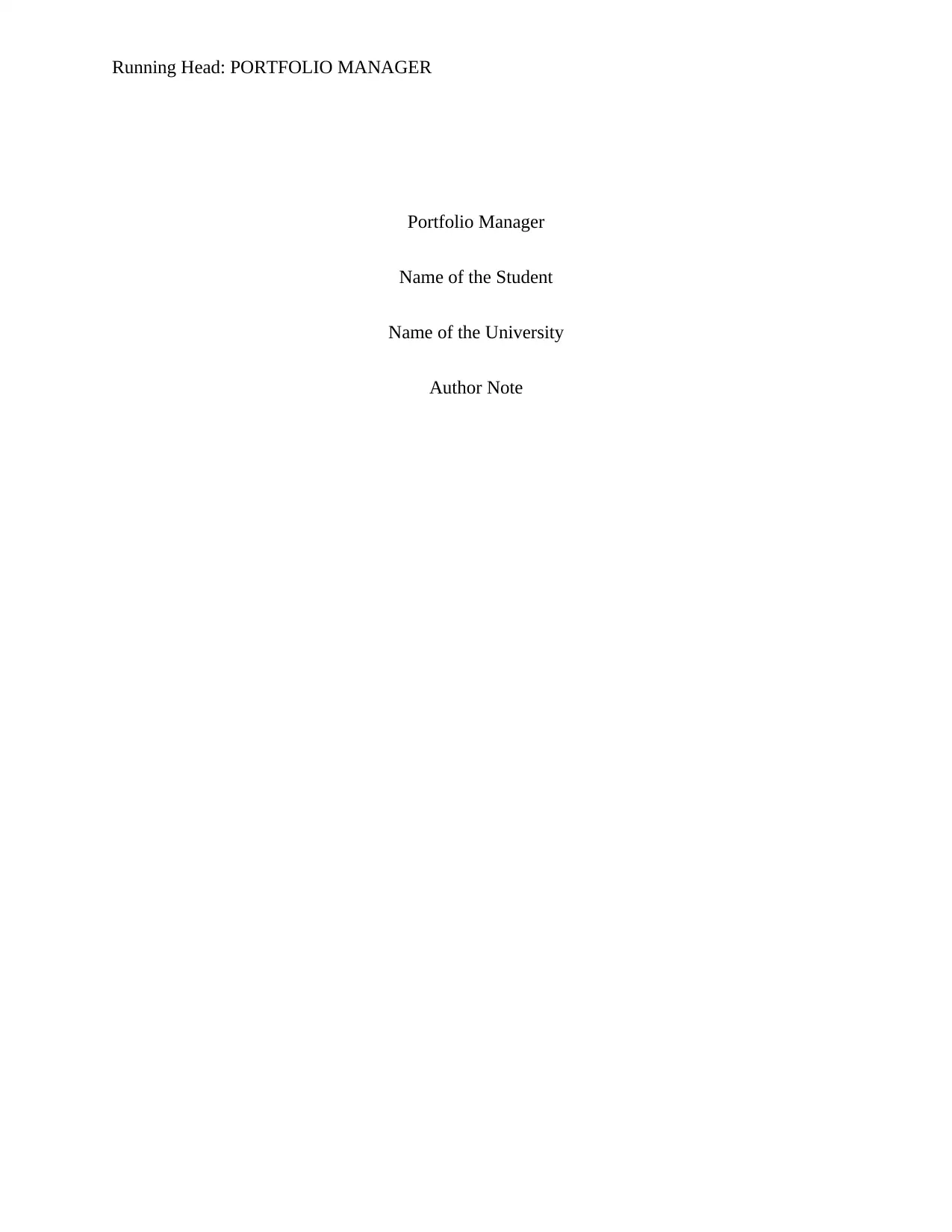
Running Head: PORTFOLIO MANAGER
Portfolio Manager
Name of the Student
Name of the University
Author Note
Portfolio Manager
Name of the Student
Name of the University
Author Note
Paraphrase This Document
Need a fresh take? Get an instant paraphrase of this document with our AI Paraphraser
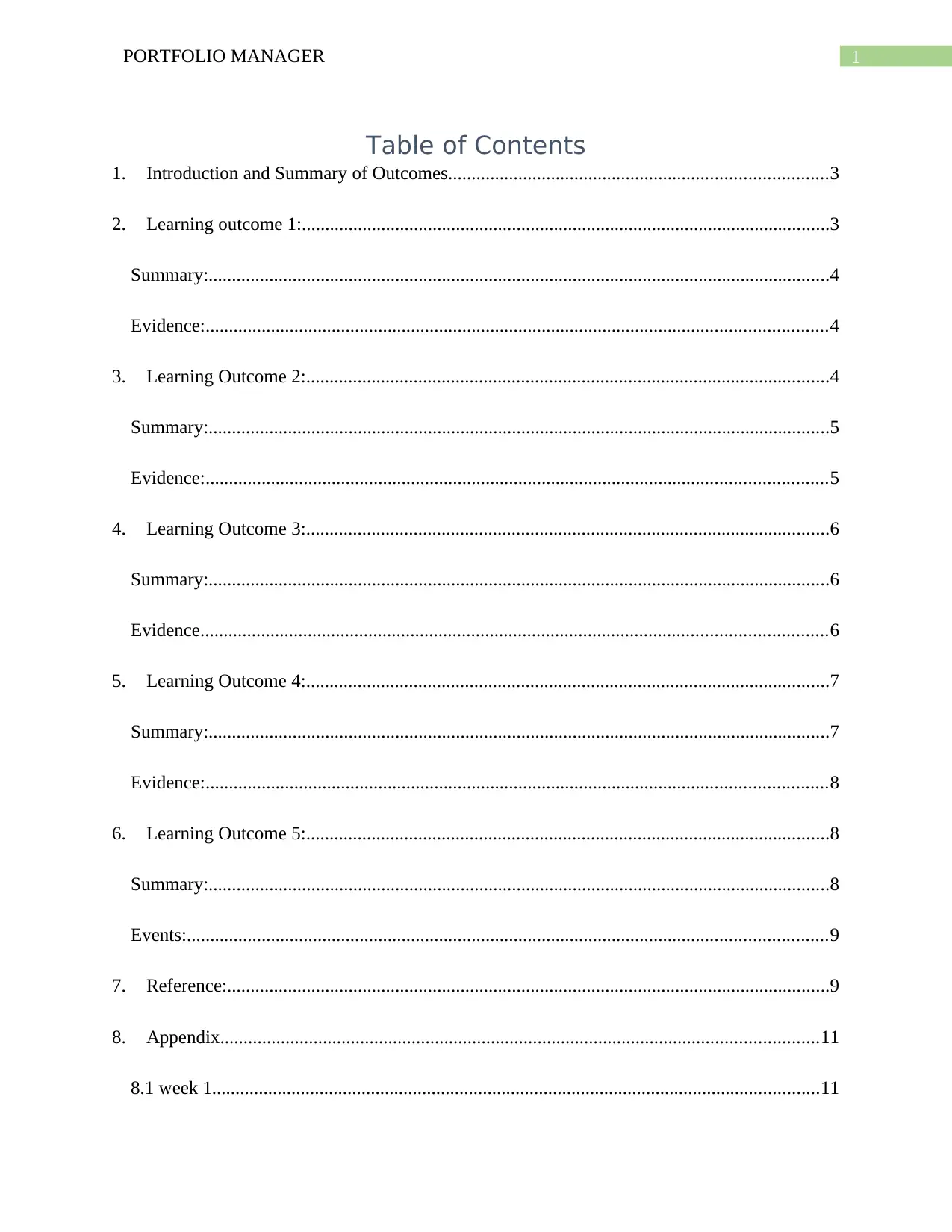
1PORTFOLIO MANAGER
Table of Contents
1. Introduction and Summary of Outcomes.................................................................................3
2. Learning outcome 1:.................................................................................................................3
Summary:.....................................................................................................................................4
Evidence:.....................................................................................................................................4
3. Learning Outcome 2:................................................................................................................4
Summary:.....................................................................................................................................5
Evidence:.....................................................................................................................................5
4. Learning Outcome 3:................................................................................................................6
Summary:.....................................................................................................................................6
Evidence......................................................................................................................................6
5. Learning Outcome 4:................................................................................................................7
Summary:.....................................................................................................................................7
Evidence:.....................................................................................................................................8
6. Learning Outcome 5:................................................................................................................8
Summary:.....................................................................................................................................8
Events:.........................................................................................................................................9
7. Reference:.................................................................................................................................9
8. Appendix................................................................................................................................11
8.1 week 1..................................................................................................................................11
Table of Contents
1. Introduction and Summary of Outcomes.................................................................................3
2. Learning outcome 1:.................................................................................................................3
Summary:.....................................................................................................................................4
Evidence:.....................................................................................................................................4
3. Learning Outcome 2:................................................................................................................4
Summary:.....................................................................................................................................5
Evidence:.....................................................................................................................................5
4. Learning Outcome 3:................................................................................................................6
Summary:.....................................................................................................................................6
Evidence......................................................................................................................................6
5. Learning Outcome 4:................................................................................................................7
Summary:.....................................................................................................................................7
Evidence:.....................................................................................................................................8
6. Learning Outcome 5:................................................................................................................8
Summary:.....................................................................................................................................8
Events:.........................................................................................................................................9
7. Reference:.................................................................................................................................9
8. Appendix................................................................................................................................11
8.1 week 1..................................................................................................................................11
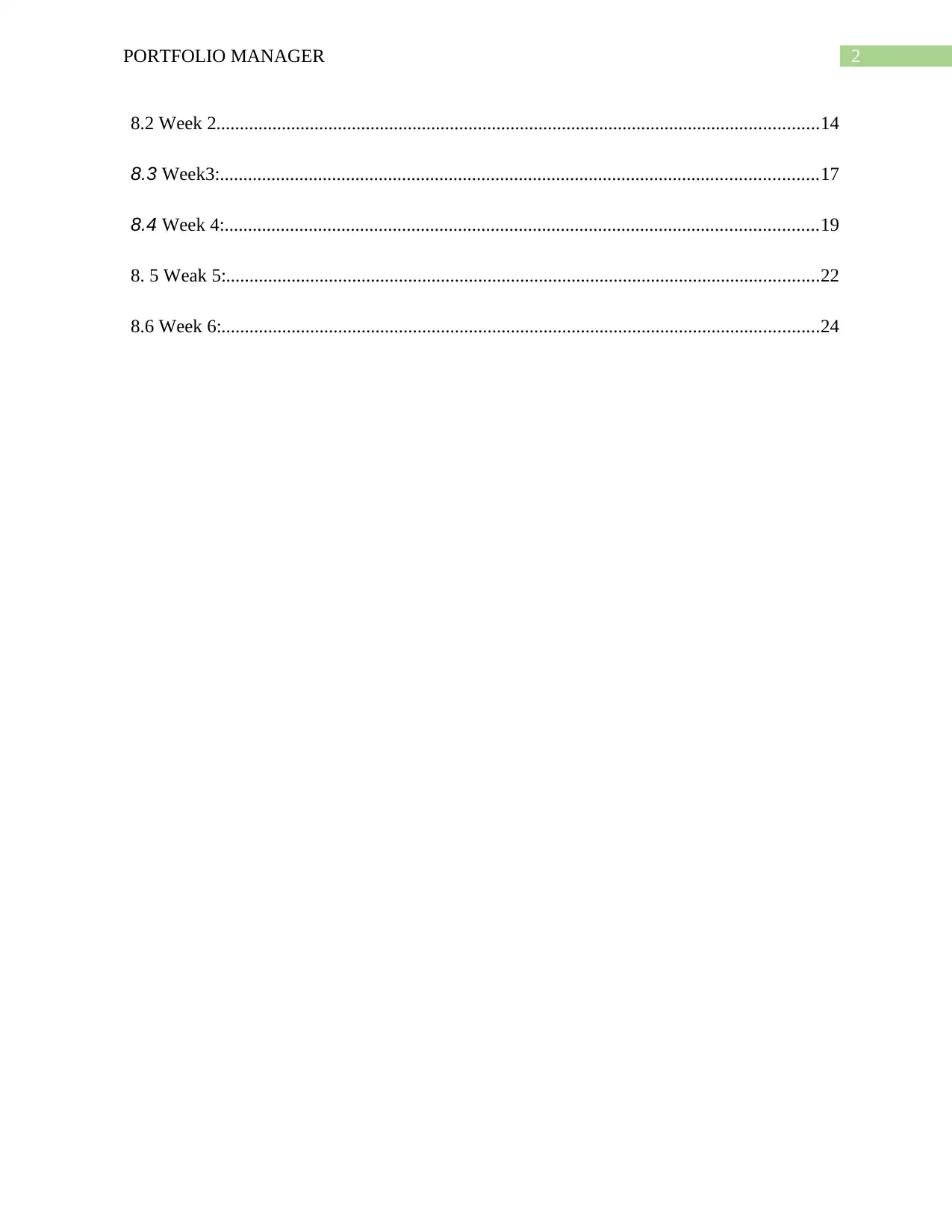
2PORTFOLIO MANAGER
8.2 Week 2.................................................................................................................................14
8.3 Week3:................................................................................................................................17
8.4 Week 4:...............................................................................................................................19
8. 5 Weak 5:...............................................................................................................................22
8.6 Week 6:................................................................................................................................24
8.2 Week 2.................................................................................................................................14
8.3 Week3:................................................................................................................................17
8.4 Week 4:...............................................................................................................................19
8. 5 Weak 5:...............................................................................................................................22
8.6 Week 6:................................................................................................................................24
⊘ This is a preview!⊘
Do you want full access?
Subscribe today to unlock all pages.

Trusted by 1+ million students worldwide
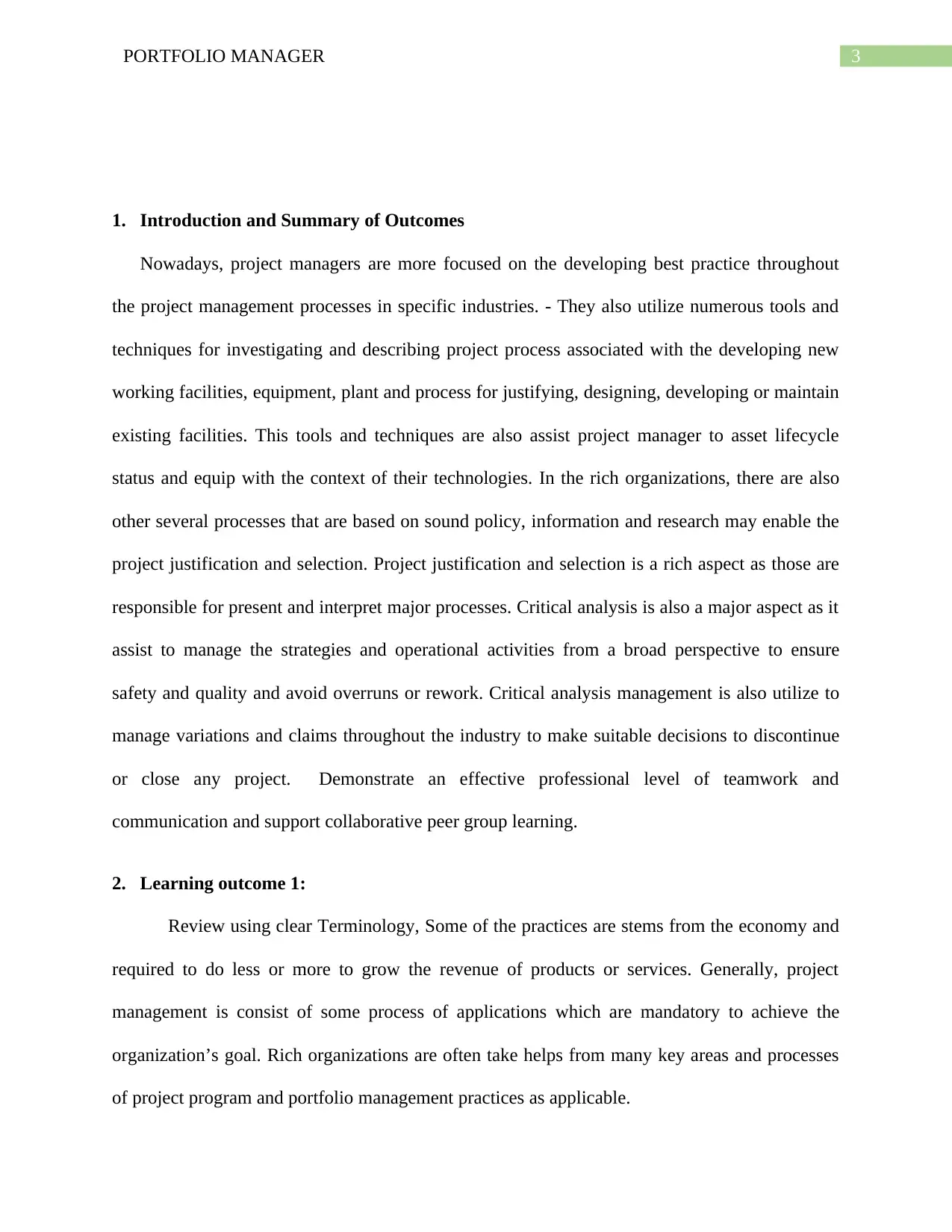
3PORTFOLIO MANAGER
1. Introduction and Summary of Outcomes
Nowadays, project managers are more focused on the developing best practice throughout
the project management processes in specific industries. - They also utilize numerous tools and
techniques for investigating and describing project process associated with the developing new
working facilities, equipment, plant and process for justifying, designing, developing or maintain
existing facilities. This tools and techniques are also assist project manager to asset lifecycle
status and equip with the context of their technologies. In the rich organizations, there are also
other several processes that are based on sound policy, information and research may enable the
project justification and selection. Project justification and selection is a rich aspect as those are
responsible for present and interpret major processes. Critical analysis is also a major aspect as it
assist to manage the strategies and operational activities from a broad perspective to ensure
safety and quality and avoid overruns or rework. Critical analysis management is also utilize to
manage variations and claims throughout the industry to make suitable decisions to discontinue
or close any project. Demonstrate an effective professional level of teamwork and
communication and support collaborative peer group learning.
2. Learning outcome 1:
Review using clear Terminology, Some of the practices are stems from the economy and
required to do less or more to grow the revenue of products or services. Generally, project
management is consist of some process of applications which are mandatory to achieve the
organization’s goal. Rich organizations are often take helps from many key areas and processes
of project program and portfolio management practices as applicable.
1. Introduction and Summary of Outcomes
Nowadays, project managers are more focused on the developing best practice throughout
the project management processes in specific industries. - They also utilize numerous tools and
techniques for investigating and describing project process associated with the developing new
working facilities, equipment, plant and process for justifying, designing, developing or maintain
existing facilities. This tools and techniques are also assist project manager to asset lifecycle
status and equip with the context of their technologies. In the rich organizations, there are also
other several processes that are based on sound policy, information and research may enable the
project justification and selection. Project justification and selection is a rich aspect as those are
responsible for present and interpret major processes. Critical analysis is also a major aspect as it
assist to manage the strategies and operational activities from a broad perspective to ensure
safety and quality and avoid overruns or rework. Critical analysis management is also utilize to
manage variations and claims throughout the industry to make suitable decisions to discontinue
or close any project. Demonstrate an effective professional level of teamwork and
communication and support collaborative peer group learning.
2. Learning outcome 1:
Review using clear Terminology, Some of the practices are stems from the economy and
required to do less or more to grow the revenue of products or services. Generally, project
management is consist of some process of applications which are mandatory to achieve the
organization’s goal. Rich organizations are often take helps from many key areas and processes
of project program and portfolio management practices as applicable.
Paraphrase This Document
Need a fresh take? Get an instant paraphrase of this document with our AI Paraphraser
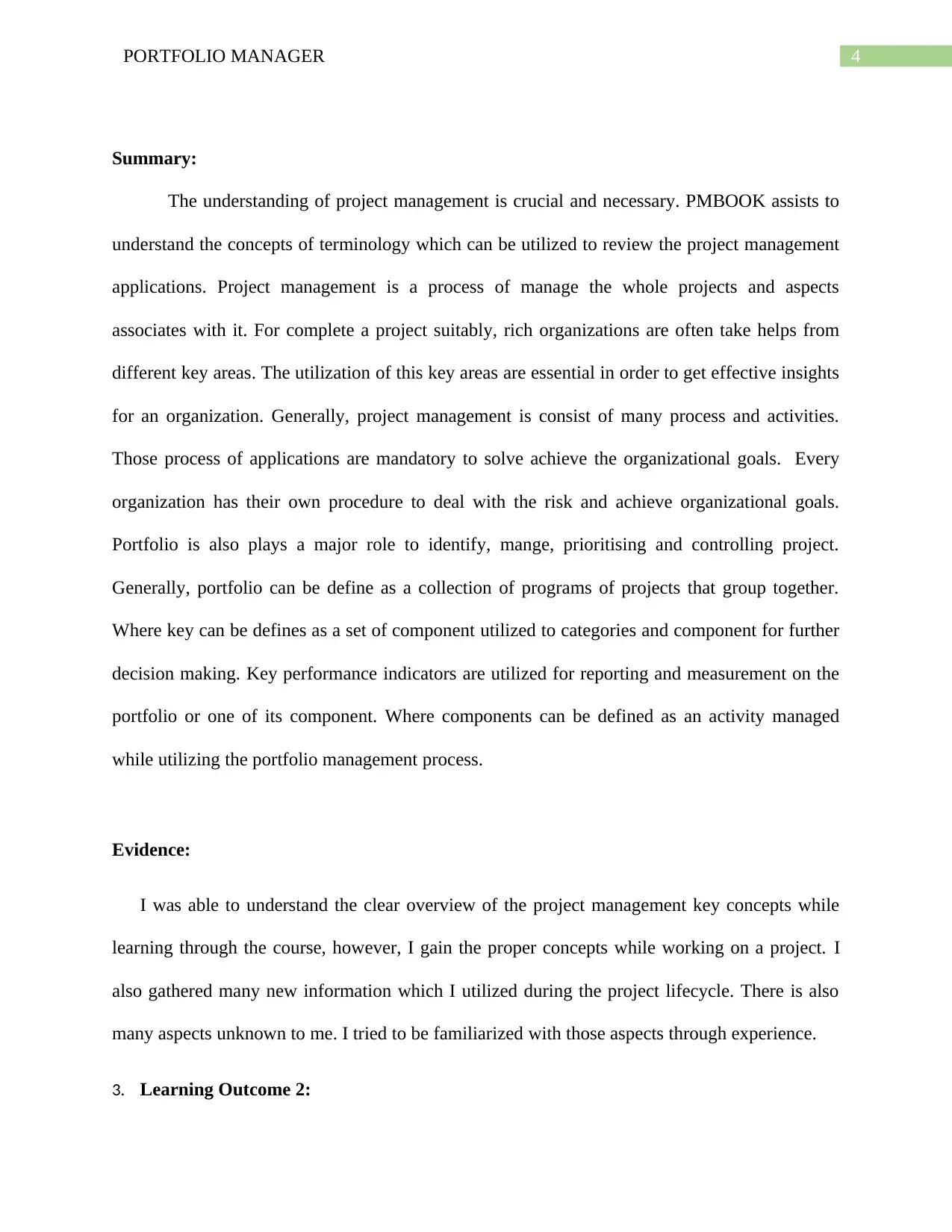
4PORTFOLIO MANAGER
Summary:
The understanding of project management is crucial and necessary. PMBOOK assists to
understand the concepts of terminology which can be utilized to review the project management
applications. Project management is a process of manage the whole projects and aspects
associates with it. For complete a project suitably, rich organizations are often take helps from
different key areas. The utilization of this key areas are essential in order to get effective insights
for an organization. Generally, project management is consist of many process and activities.
Those process of applications are mandatory to solve achieve the organizational goals. Every
organization has their own procedure to deal with the risk and achieve organizational goals.
Portfolio is also plays a major role to identify, mange, prioritising and controlling project.
Generally, portfolio can be define as a collection of programs of projects that group together.
Where key can be defines as a set of component utilized to categories and component for further
decision making. Key performance indicators are utilized for reporting and measurement on the
portfolio or one of its component. Where components can be defined as an activity managed
while utilizing the portfolio management process.
Evidence:
I was able to understand the clear overview of the project management key concepts while
learning through the course, however, I gain the proper concepts while working on a project. I
also gathered many new information which I utilized during the project lifecycle. There is also
many aspects unknown to me. I tried to be familiarized with those aspects through experience.
3. Learning Outcome 2:
Summary:
The understanding of project management is crucial and necessary. PMBOOK assists to
understand the concepts of terminology which can be utilized to review the project management
applications. Project management is a process of manage the whole projects and aspects
associates with it. For complete a project suitably, rich organizations are often take helps from
different key areas. The utilization of this key areas are essential in order to get effective insights
for an organization. Generally, project management is consist of many process and activities.
Those process of applications are mandatory to solve achieve the organizational goals. Every
organization has their own procedure to deal with the risk and achieve organizational goals.
Portfolio is also plays a major role to identify, mange, prioritising and controlling project.
Generally, portfolio can be define as a collection of programs of projects that group together.
Where key can be defines as a set of component utilized to categories and component for further
decision making. Key performance indicators are utilized for reporting and measurement on the
portfolio or one of its component. Where components can be defined as an activity managed
while utilizing the portfolio management process.
Evidence:
I was able to understand the clear overview of the project management key concepts while
learning through the course, however, I gain the proper concepts while working on a project. I
also gathered many new information which I utilized during the project lifecycle. There is also
many aspects unknown to me. I tried to be familiarized with those aspects through experience.
3. Learning Outcome 2:
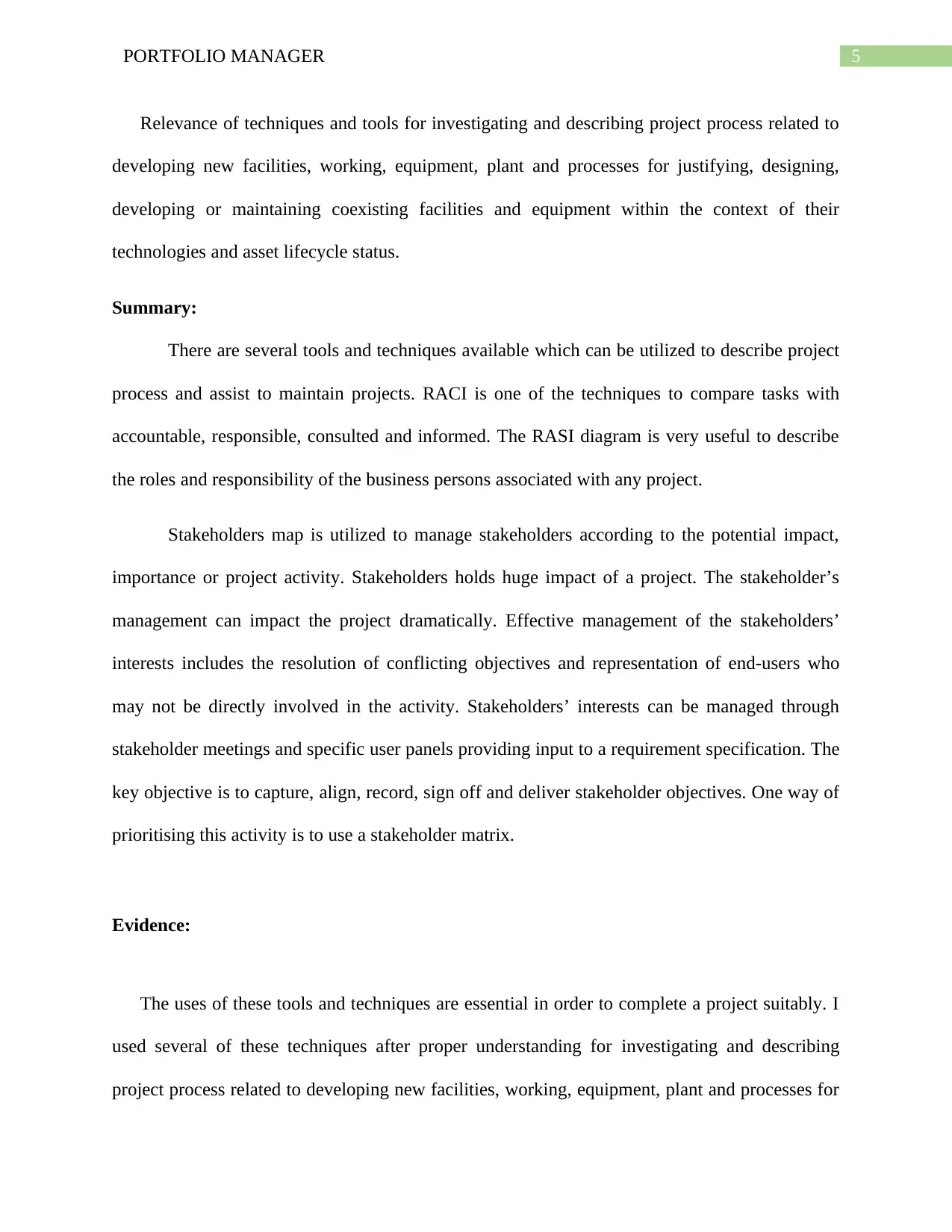
5PORTFOLIO MANAGER
Relevance of techniques and tools for investigating and describing project process related to
developing new facilities, working, equipment, plant and processes for justifying, designing,
developing or maintaining coexisting facilities and equipment within the context of their
technologies and asset lifecycle status.
Summary:
There are several tools and techniques available which can be utilized to describe project
process and assist to maintain projects. RACI is one of the techniques to compare tasks with
accountable, responsible, consulted and informed. The RASI diagram is very useful to describe
the roles and responsibility of the business persons associated with any project.
Stakeholders map is utilized to manage stakeholders according to the potential impact,
importance or project activity. Stakeholders holds huge impact of a project. The stakeholder’s
management can impact the project dramatically. Effective management of the stakeholders’
interests includes the resolution of conflicting objectives and representation of end-users who
may not be directly involved in the activity. Stakeholders’ interests can be managed through
stakeholder meetings and specific user panels providing input to a requirement specification. The
key objective is to capture, align, record, sign off and deliver stakeholder objectives. One way of
prioritising this activity is to use a stakeholder matrix.
Evidence:
The uses of these tools and techniques are essential in order to complete a project suitably. I
used several of these techniques after proper understanding for investigating and describing
project process related to developing new facilities, working, equipment, plant and processes for
Relevance of techniques and tools for investigating and describing project process related to
developing new facilities, working, equipment, plant and processes for justifying, designing,
developing or maintaining coexisting facilities and equipment within the context of their
technologies and asset lifecycle status.
Summary:
There are several tools and techniques available which can be utilized to describe project
process and assist to maintain projects. RACI is one of the techniques to compare tasks with
accountable, responsible, consulted and informed. The RASI diagram is very useful to describe
the roles and responsibility of the business persons associated with any project.
Stakeholders map is utilized to manage stakeholders according to the potential impact,
importance or project activity. Stakeholders holds huge impact of a project. The stakeholder’s
management can impact the project dramatically. Effective management of the stakeholders’
interests includes the resolution of conflicting objectives and representation of end-users who
may not be directly involved in the activity. Stakeholders’ interests can be managed through
stakeholder meetings and specific user panels providing input to a requirement specification. The
key objective is to capture, align, record, sign off and deliver stakeholder objectives. One way of
prioritising this activity is to use a stakeholder matrix.
Evidence:
The uses of these tools and techniques are essential in order to complete a project suitably. I
used several of these techniques after proper understanding for investigating and describing
project process related to developing new facilities, working, equipment, plant and processes for
⊘ This is a preview!⊘
Do you want full access?
Subscribe today to unlock all pages.

Trusted by 1+ million students worldwide
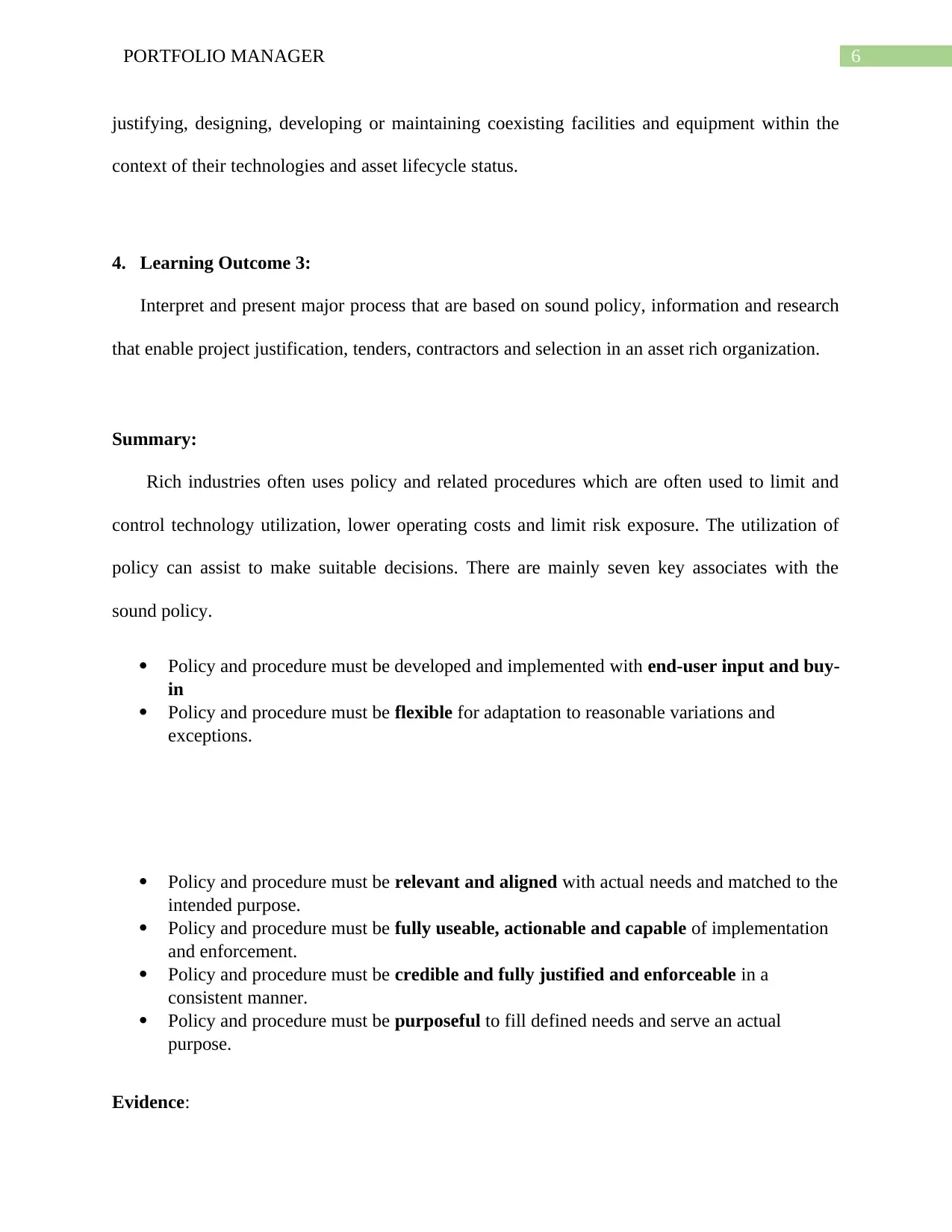
6PORTFOLIO MANAGER
justifying, designing, developing or maintaining coexisting facilities and equipment within the
context of their technologies and asset lifecycle status.
4. Learning Outcome 3:
Interpret and present major process that are based on sound policy, information and research
that enable project justification, tenders, contractors and selection in an asset rich organization.
Summary:
Rich industries often uses policy and related procedures which are often used to limit and
control technology utilization, lower operating costs and limit risk exposure. The utilization of
policy can assist to make suitable decisions. There are mainly seven key associates with the
sound policy.
Policy and procedure must be developed and implemented with end-user input and buy-
in
Policy and procedure must be flexible for adaptation to reasonable variations and
exceptions.
Policy and procedure must be relevant and aligned with actual needs and matched to the
intended purpose.
Policy and procedure must be fully useable, actionable and capable of implementation
and enforcement.
Policy and procedure must be credible and fully justified and enforceable in a
consistent manner.
Policy and procedure must be purposeful to fill defined needs and serve an actual
purpose.
Evidence:
justifying, designing, developing or maintaining coexisting facilities and equipment within the
context of their technologies and asset lifecycle status.
4. Learning Outcome 3:
Interpret and present major process that are based on sound policy, information and research
that enable project justification, tenders, contractors and selection in an asset rich organization.
Summary:
Rich industries often uses policy and related procedures which are often used to limit and
control technology utilization, lower operating costs and limit risk exposure. The utilization of
policy can assist to make suitable decisions. There are mainly seven key associates with the
sound policy.
Policy and procedure must be developed and implemented with end-user input and buy-
in
Policy and procedure must be flexible for adaptation to reasonable variations and
exceptions.
Policy and procedure must be relevant and aligned with actual needs and matched to the
intended purpose.
Policy and procedure must be fully useable, actionable and capable of implementation
and enforcement.
Policy and procedure must be credible and fully justified and enforceable in a
consistent manner.
Policy and procedure must be purposeful to fill defined needs and serve an actual
purpose.
Evidence:
Paraphrase This Document
Need a fresh take? Get an instant paraphrase of this document with our AI Paraphraser
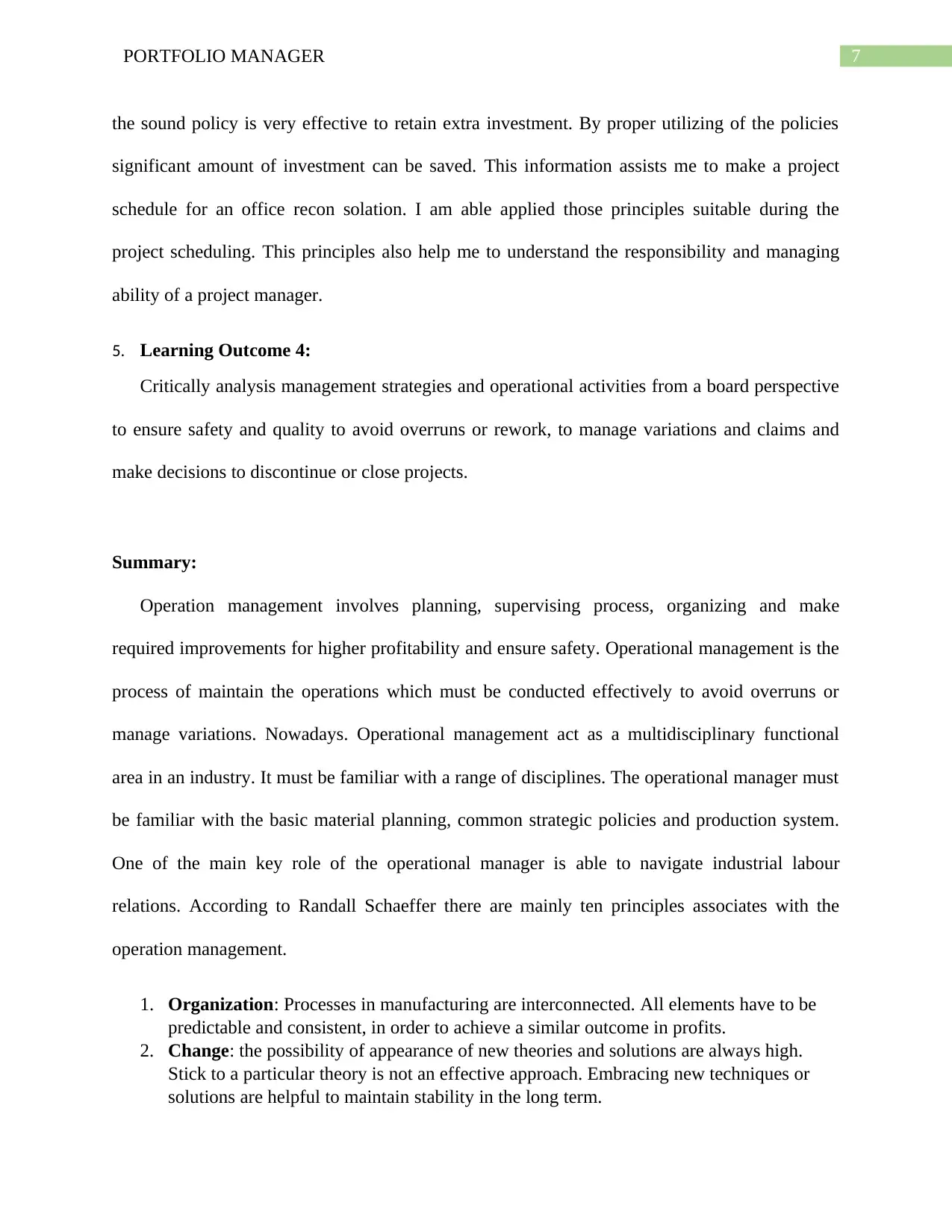
7PORTFOLIO MANAGER
the sound policy is very effective to retain extra investment. By proper utilizing of the policies
significant amount of investment can be saved. This information assists me to make a project
schedule for an office recon solation. I am able applied those principles suitable during the
project scheduling. This principles also help me to understand the responsibility and managing
ability of a project manager.
5. Learning Outcome 4:
Critically analysis management strategies and operational activities from a board perspective
to ensure safety and quality to avoid overruns or rework, to manage variations and claims and
make decisions to discontinue or close projects.
Summary:
Operation management involves planning, supervising process, organizing and make
required improvements for higher profitability and ensure safety. Operational management is the
process of maintain the operations which must be conducted effectively to avoid overruns or
manage variations. Nowadays. Operational management act as a multidisciplinary functional
area in an industry. It must be familiar with a range of disciplines. The operational manager must
be familiar with the basic material planning, common strategic policies and production system.
One of the main key role of the operational manager is able to navigate industrial labour
relations. According to Randall Schaeffer there are mainly ten principles associates with the
operation management.
1. Organization: Processes in manufacturing are interconnected. All elements have to be
predictable and consistent, in order to achieve a similar outcome in profits.
2. Change: the possibility of appearance of new theories and solutions are always high.
Stick to a particular theory is not an effective approach. Embracing new techniques or
solutions are helpful to maintain stability in the long term.
the sound policy is very effective to retain extra investment. By proper utilizing of the policies
significant amount of investment can be saved. This information assists me to make a project
schedule for an office recon solation. I am able applied those principles suitable during the
project scheduling. This principles also help me to understand the responsibility and managing
ability of a project manager.
5. Learning Outcome 4:
Critically analysis management strategies and operational activities from a board perspective
to ensure safety and quality to avoid overruns or rework, to manage variations and claims and
make decisions to discontinue or close projects.
Summary:
Operation management involves planning, supervising process, organizing and make
required improvements for higher profitability and ensure safety. Operational management is the
process of maintain the operations which must be conducted effectively to avoid overruns or
manage variations. Nowadays. Operational management act as a multidisciplinary functional
area in an industry. It must be familiar with a range of disciplines. The operational manager must
be familiar with the basic material planning, common strategic policies and production system.
One of the main key role of the operational manager is able to navigate industrial labour
relations. According to Randall Schaeffer there are mainly ten principles associates with the
operation management.
1. Organization: Processes in manufacturing are interconnected. All elements have to be
predictable and consistent, in order to achieve a similar outcome in profits.
2. Change: the possibility of appearance of new theories and solutions are always high.
Stick to a particular theory is not an effective approach. Embracing new techniques or
solutions are helpful to maintain stability in the long term.
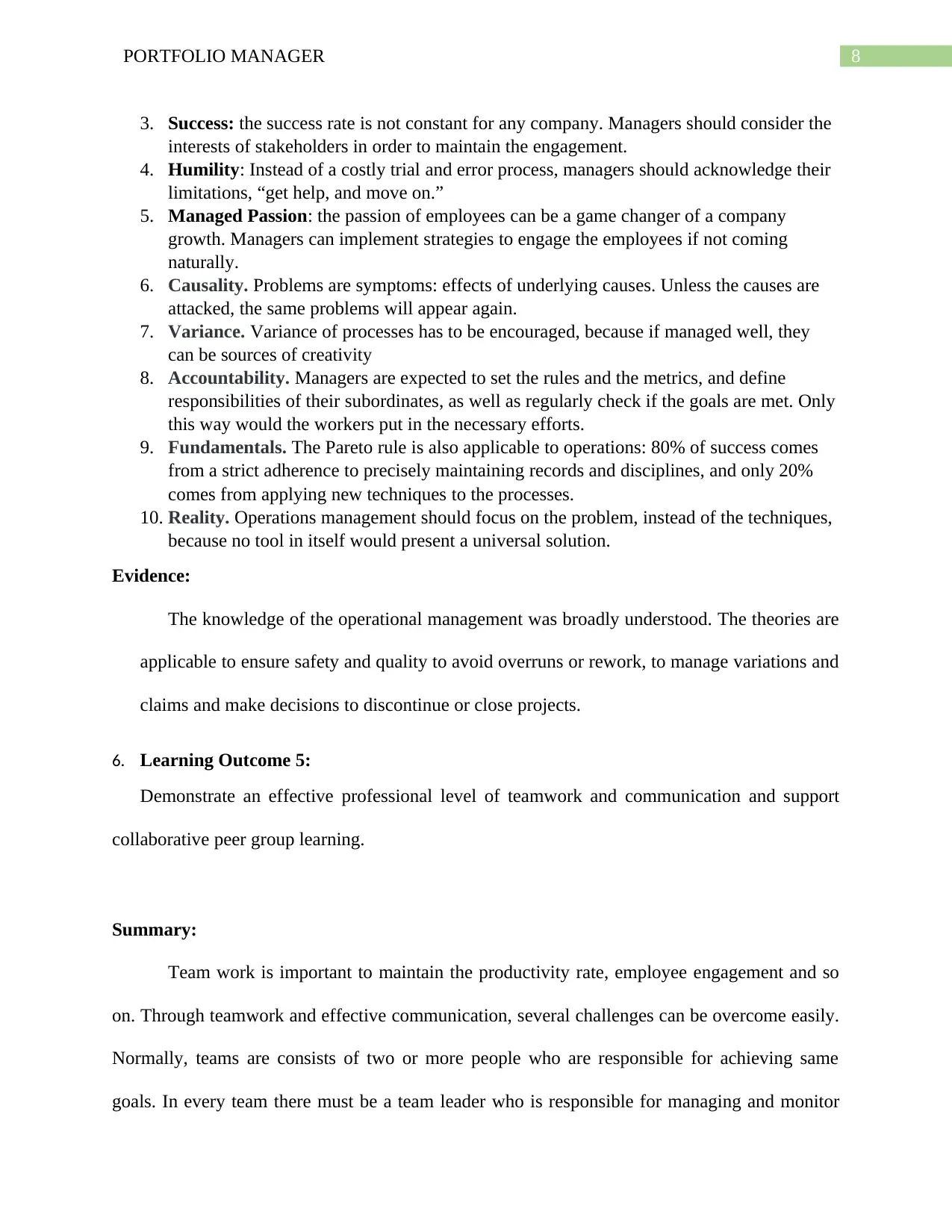
8PORTFOLIO MANAGER
3. Success: the success rate is not constant for any company. Managers should consider the
interests of stakeholders in order to maintain the engagement.
4. Humility: Instead of a costly trial and error process, managers should acknowledge their
limitations, “get help, and move on.”
5. Managed Passion: the passion of employees can be a game changer of a company
growth. Managers can implement strategies to engage the employees if not coming
naturally.
6. Causality. Problems are symptoms: effects of underlying causes. Unless the causes are
attacked, the same problems will appear again.
7. Variance. Variance of processes has to be encouraged, because if managed well, they
can be sources of creativity
8. Accountability. Managers are expected to set the rules and the metrics, and define
responsibilities of their subordinates, as well as regularly check if the goals are met. Only
this way would the workers put in the necessary efforts.
9. Fundamentals. The Pareto rule is also applicable to operations: 80% of success comes
from a strict adherence to precisely maintaining records and disciplines, and only 20%
comes from applying new techniques to the processes.
10. Reality. Operations management should focus on the problem, instead of the techniques,
because no tool in itself would present a universal solution.
Evidence:
The knowledge of the operational management was broadly understood. The theories are
applicable to ensure safety and quality to avoid overruns or rework, to manage variations and
claims and make decisions to discontinue or close projects.
6. Learning Outcome 5:
Demonstrate an effective professional level of teamwork and communication and support
collaborative peer group learning.
Summary:
Team work is important to maintain the productivity rate, employee engagement and so
on. Through teamwork and effective communication, several challenges can be overcome easily.
Normally, teams are consists of two or more people who are responsible for achieving same
goals. In every team there must be a team leader who is responsible for managing and monitor
3. Success: the success rate is not constant for any company. Managers should consider the
interests of stakeholders in order to maintain the engagement.
4. Humility: Instead of a costly trial and error process, managers should acknowledge their
limitations, “get help, and move on.”
5. Managed Passion: the passion of employees can be a game changer of a company
growth. Managers can implement strategies to engage the employees if not coming
naturally.
6. Causality. Problems are symptoms: effects of underlying causes. Unless the causes are
attacked, the same problems will appear again.
7. Variance. Variance of processes has to be encouraged, because if managed well, they
can be sources of creativity
8. Accountability. Managers are expected to set the rules and the metrics, and define
responsibilities of their subordinates, as well as regularly check if the goals are met. Only
this way would the workers put in the necessary efforts.
9. Fundamentals. The Pareto rule is also applicable to operations: 80% of success comes
from a strict adherence to precisely maintaining records and disciplines, and only 20%
comes from applying new techniques to the processes.
10. Reality. Operations management should focus on the problem, instead of the techniques,
because no tool in itself would present a universal solution.
Evidence:
The knowledge of the operational management was broadly understood. The theories are
applicable to ensure safety and quality to avoid overruns or rework, to manage variations and
claims and make decisions to discontinue or close projects.
6. Learning Outcome 5:
Demonstrate an effective professional level of teamwork and communication and support
collaborative peer group learning.
Summary:
Team work is important to maintain the productivity rate, employee engagement and so
on. Through teamwork and effective communication, several challenges can be overcome easily.
Normally, teams are consists of two or more people who are responsible for achieving same
goals. In every team there must be a team leader who is responsible for managing and monitor
⊘ This is a preview!⊘
Do you want full access?
Subscribe today to unlock all pages.

Trusted by 1+ million students worldwide
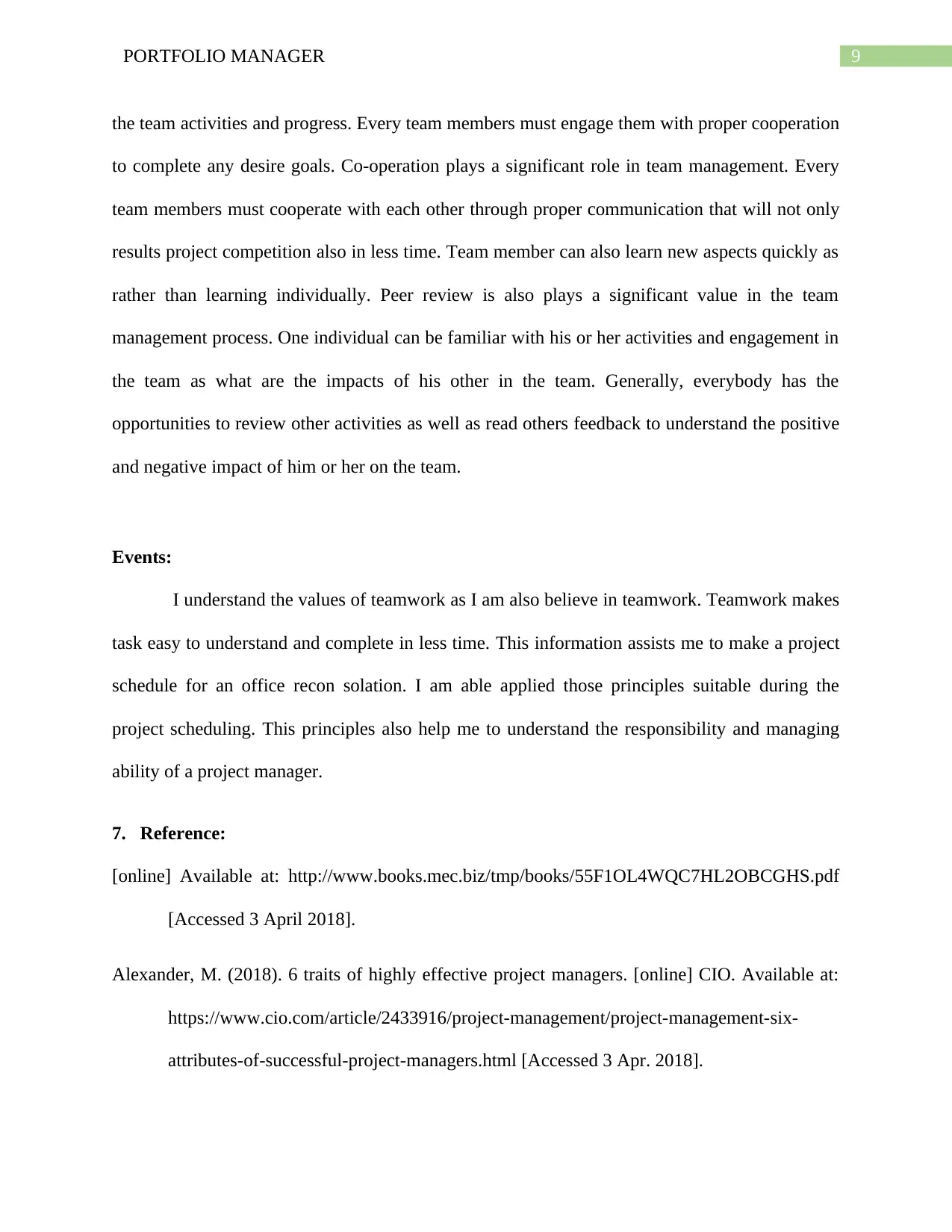
9PORTFOLIO MANAGER
the team activities and progress. Every team members must engage them with proper cooperation
to complete any desire goals. Co-operation plays a significant role in team management. Every
team members must cooperate with each other through proper communication that will not only
results project competition also in less time. Team member can also learn new aspects quickly as
rather than learning individually. Peer review is also plays a significant value in the team
management process. One individual can be familiar with his or her activities and engagement in
the team as what are the impacts of his other in the team. Generally, everybody has the
opportunities to review other activities as well as read others feedback to understand the positive
and negative impact of him or her on the team.
Events:
I understand the values of teamwork as I am also believe in teamwork. Teamwork makes
task easy to understand and complete in less time. This information assists me to make a project
schedule for an office recon solation. I am able applied those principles suitable during the
project scheduling. This principles also help me to understand the responsibility and managing
ability of a project manager.
7. Reference:
[online] Available at: http://www.books.mec.biz/tmp/books/55F1OL4WQC7HL2OBCGHS.pdf
[Accessed 3 April 2018].
Alexander, M. (2018). 6 traits of highly effective project managers. [online] CIO. Available at:
https://www.cio.com/article/2433916/project-management/project-management-six-
attributes-of-successful-project-managers.html [Accessed 3 Apr. 2018].
the team activities and progress. Every team members must engage them with proper cooperation
to complete any desire goals. Co-operation plays a significant role in team management. Every
team members must cooperate with each other through proper communication that will not only
results project competition also in less time. Team member can also learn new aspects quickly as
rather than learning individually. Peer review is also plays a significant value in the team
management process. One individual can be familiar with his or her activities and engagement in
the team as what are the impacts of his other in the team. Generally, everybody has the
opportunities to review other activities as well as read others feedback to understand the positive
and negative impact of him or her on the team.
Events:
I understand the values of teamwork as I am also believe in teamwork. Teamwork makes
task easy to understand and complete in less time. This information assists me to make a project
schedule for an office recon solation. I am able applied those principles suitable during the
project scheduling. This principles also help me to understand the responsibility and managing
ability of a project manager.
7. Reference:
[online] Available at: http://www.books.mec.biz/tmp/books/55F1OL4WQC7HL2OBCGHS.pdf
[Accessed 3 April 2018].
Alexander, M. (2018). 6 traits of highly effective project managers. [online] CIO. Available at:
https://www.cio.com/article/2433916/project-management/project-management-six-
attributes-of-successful-project-managers.html [Accessed 3 Apr. 2018].
Paraphrase This Document
Need a fresh take? Get an instant paraphrase of this document with our AI Paraphraser
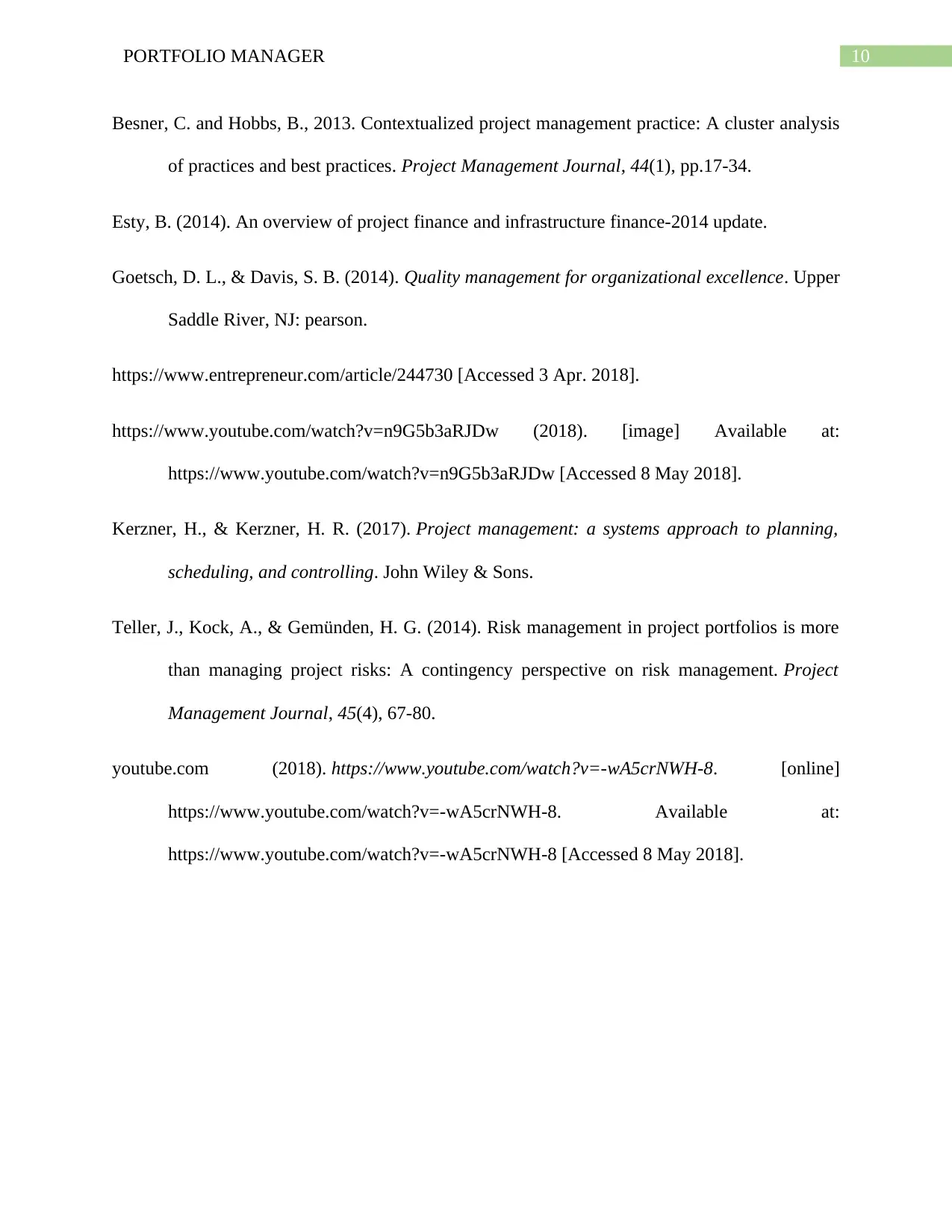
10PORTFOLIO MANAGER
Besner, C. and Hobbs, B., 2013. Contextualized project management practice: A cluster analysis
of practices and best practices. Project Management Journal, 44(1), pp.17-34.
Esty, B. (2014). An overview of project finance and infrastructure finance-2014 update.
Goetsch, D. L., & Davis, S. B. (2014). Quality management for organizational excellence. Upper
Saddle River, NJ: pearson.
https://www.entrepreneur.com/article/244730 [Accessed 3 Apr. 2018].
https://www.youtube.com/watch?v=n9G5b3aRJDw (2018). [image] Available at:
https://www.youtube.com/watch?v=n9G5b3aRJDw [Accessed 8 May 2018].
Kerzner, H., & Kerzner, H. R. (2017). Project management: a systems approach to planning,
scheduling, and controlling. John Wiley & Sons.
Teller, J., Kock, A., & Gemünden, H. G. (2014). Risk management in project portfolios is more
than managing project risks: A contingency perspective on risk management. Project
Management Journal, 45(4), 67-80.
youtube.com (2018). https://www.youtube.com/watch?v=-wA5crNWH-8. [online]
https://www.youtube.com/watch?v=-wA5crNWH-8. Available at:
https://www.youtube.com/watch?v=-wA5crNWH-8 [Accessed 8 May 2018].
Besner, C. and Hobbs, B., 2013. Contextualized project management practice: A cluster analysis
of practices and best practices. Project Management Journal, 44(1), pp.17-34.
Esty, B. (2014). An overview of project finance and infrastructure finance-2014 update.
Goetsch, D. L., & Davis, S. B. (2014). Quality management for organizational excellence. Upper
Saddle River, NJ: pearson.
https://www.entrepreneur.com/article/244730 [Accessed 3 Apr. 2018].
https://www.youtube.com/watch?v=n9G5b3aRJDw (2018). [image] Available at:
https://www.youtube.com/watch?v=n9G5b3aRJDw [Accessed 8 May 2018].
Kerzner, H., & Kerzner, H. R. (2017). Project management: a systems approach to planning,
scheduling, and controlling. John Wiley & Sons.
Teller, J., Kock, A., & Gemünden, H. G. (2014). Risk management in project portfolios is more
than managing project risks: A contingency perspective on risk management. Project
Management Journal, 45(4), 67-80.
youtube.com (2018). https://www.youtube.com/watch?v=-wA5crNWH-8. [online]
https://www.youtube.com/watch?v=-wA5crNWH-8. Available at:
https://www.youtube.com/watch?v=-wA5crNWH-8 [Accessed 8 May 2018].
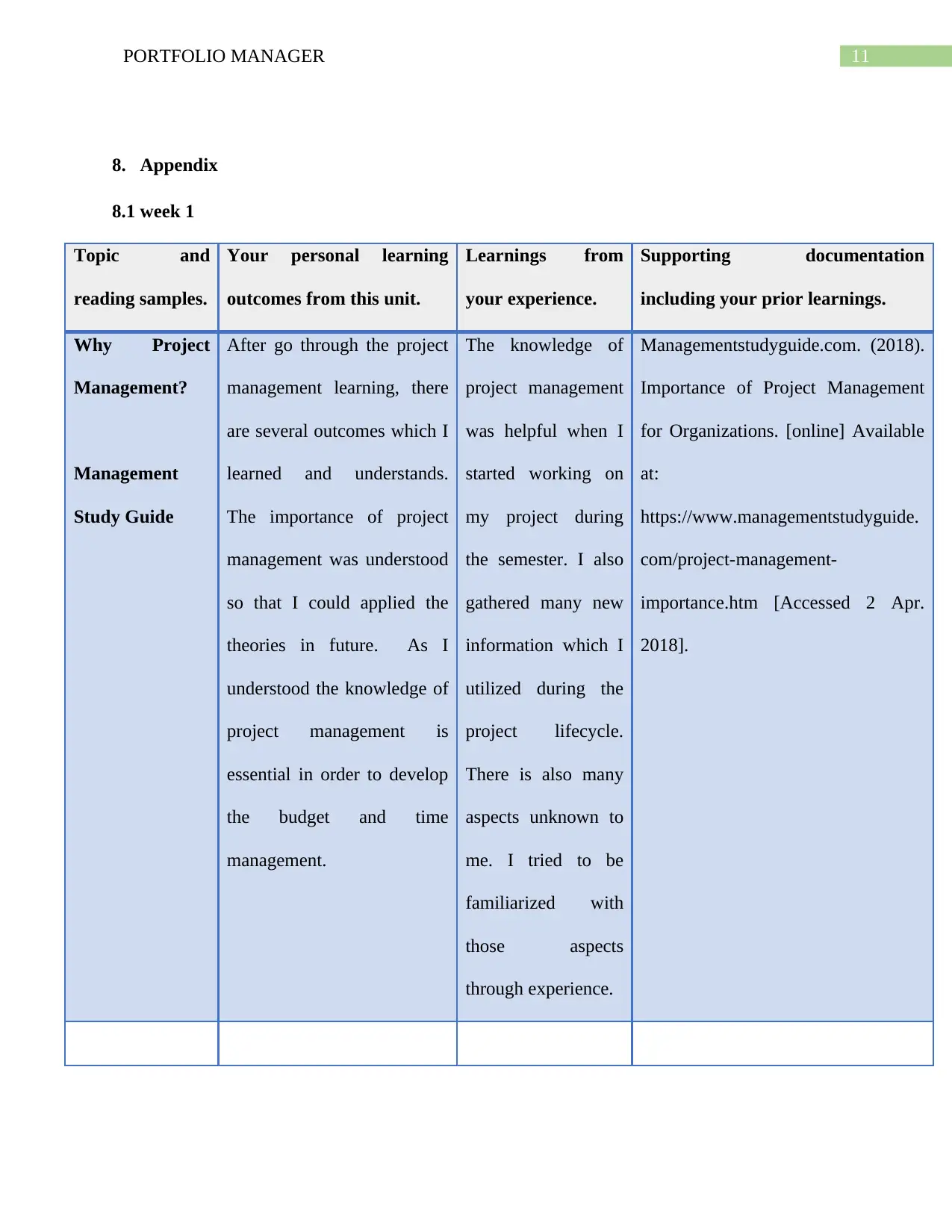
11PORTFOLIO MANAGER
8. Appendix
8.1 week 1
Topic and
reading samples.
Your personal learning
outcomes from this unit.
Learnings from
your experience.
Supporting documentation
including your prior learnings.
Why Project
Management?
Management
Study Guide
After go through the project
management learning, there
are several outcomes which I
learned and understands.
The importance of project
management was understood
so that I could applied the
theories in future. As I
understood the knowledge of
project management is
essential in order to develop
the budget and time
management.
The knowledge of
project management
was helpful when I
started working on
my project during
the semester. I also
gathered many new
information which I
utilized during the
project lifecycle.
There is also many
aspects unknown to
me. I tried to be
familiarized with
those aspects
through experience.
Managementstudyguide.com. (2018).
Importance of Project Management
for Organizations. [online] Available
at:
https://www.managementstudyguide.
com/project-management-
importance.htm [Accessed 2 Apr.
2018].
8. Appendix
8.1 week 1
Topic and
reading samples.
Your personal learning
outcomes from this unit.
Learnings from
your experience.
Supporting documentation
including your prior learnings.
Why Project
Management?
Management
Study Guide
After go through the project
management learning, there
are several outcomes which I
learned and understands.
The importance of project
management was understood
so that I could applied the
theories in future. As I
understood the knowledge of
project management is
essential in order to develop
the budget and time
management.
The knowledge of
project management
was helpful when I
started working on
my project during
the semester. I also
gathered many new
information which I
utilized during the
project lifecycle.
There is also many
aspects unknown to
me. I tried to be
familiarized with
those aspects
through experience.
Managementstudyguide.com. (2018).
Importance of Project Management
for Organizations. [online] Available
at:
https://www.managementstudyguide.
com/project-management-
importance.htm [Accessed 2 Apr.
2018].
⊘ This is a preview!⊘
Do you want full access?
Subscribe today to unlock all pages.

Trusted by 1+ million students worldwide
1 out of 25
Related Documents
Your All-in-One AI-Powered Toolkit for Academic Success.
+13062052269
info@desklib.com
Available 24*7 on WhatsApp / Email
![[object Object]](/_next/static/media/star-bottom.7253800d.svg)
Unlock your academic potential
Copyright © 2020–2025 A2Z Services. All Rights Reserved. Developed and managed by ZUCOL.




